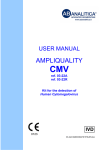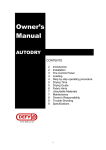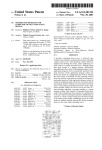Download Healty Smiles, Health Families - Boys & Girls Clubs of America
Transcript
Sponsored by Important Guidelines for Photocopying Limited permission is granted free of charge to Boys & Girls Club staff members to reproduce pages of this guide for use by parents of Boys & Girls Club members. Under no circumstances is it permissible to sell or distribute on a commercial basis multiple copies of material reproduced from this publication. Copyright © 2004 Boys & Girls Clubs of America All rights reserved. Printed in the United States of America. Except as expressly provided above, no part of this publication may be reproduced or transmitted in any form or by any means, electronic or mechanical, including photocopying, recording, or by any information storage and retrieval system, without written permission of the publisher. Table of Contents A Letter to Parents . . . . . . . . . . . . . . . . . . . . . . . . . . . . . . . . . . . . . . . . . . . . . . . . . . . .3 Your Children’s Oral Health Team . . . . . . . . . . . . . . . . . . . . . . . . . . . . . . . . . . . . . . . . .4 The Coach: The Parent or Caregiver . . . . . . . . . . . . . . . . . . . . . . . . . . . . . . . . . . . . . . . . . . . . . . . . . . . .4 Team Member No. 1: Your Child . . . . . . . . . . . . . . . . . . . . . . . . . . . . . . . . . . . . . . . . . . . . . . . . . . . . . . . .4 Other Team Members: Dental Professionals . . . . . . . . . . . . . . . . . . . . . . . . . . . . . . . . . . . . . . . . . . . . .4 The Cheerleaders: Boys & Girls Club Staff and Volunteers . . . . . . . . . . . . . . . . . . . . . . . . . . . . . . . . .4 The Boosters: Community Helpers . . . . . . . . . . . . . . . . . . . . . . . . . . . . . . . . . . . . . . . . . . . . . . . . . . . . . .4 Oral Health Basics . . . . . . . . . . . . . . . . . . . . . . . . . . . . . . . . . . . . . . . . . . . . . . . . . . . . . .7 A Family Oral Health Plan . . . . . . . . . . . . . . . . . . . . . . . . . . . . . . . . . . . . . . . . . . . . . . . . . . . . . . . . . . . . . .7 Parent Checklist: Improving your Children’s Oral Health . . . . . . . . . . . . . . . . . . . . . . . . . . . . . . . . . . .8 Visiting the Dentist: A Chart for Check-Ups . . . . . . . . . . . . . . . . . . . . . . . . . . . . . . . . . . . . . . . . . . . . .10 A Family Dental Health Contract . . . . . . . . . . . . . . . . . . . . . . . . . . . . . . . . . . . . . . . . . . . . . . . . . . . . . . .12 Dental Health Dos: What Children Should Know and Do . . . . . . . . . . . . . . . . . . . .13 Activity for Parents and Children Ages 6 to 9: “Friends in the Village of Teeth” . . . . . . . . . . . . . .14 Activity for Parents and Children Ages 10 to 12: “The Jenkins Family Visits the Dentist” . . . . .16 Activity for Parents and Children Ages 13 to 15: “Chewing your Way to Gum Disease” . . . . . .18 Dental Health Don’ts: What Children Should Avoid . . . . . . . . . . . . . . . . . . . . . . . . .20 Studs and Duds: Don’t Put a Hole in your Smile . . . . . . . . . . . . . . . . . . . . . . . . . . . . . . . . . . . . . . . . .20 Spit That Out! . . . . . . . . . . . . . . . . . . . . . . . . . . . . . . . . . . . . . . . . . . . . . . . . . . . . . . . . . . . . . . . . . . . . . . .20 Healthy Eating, Healthy Teeth: A Note about Good Nutrition . . . . . . . . . . . . . . . .21 Some Common Dental Problems Defined . . . . . . . . . . . . . . . . . . . . . . . . . . . . . . . .22 Getting Dental Care . . . . . . . . . . . . . . . . . . . . . . . . . . . . . . . . . . . . . . . . . . . . . . . . . .22 Choosing a Dentist . . . . . . . . . . . . . . . . . . . . . . . . . . . . . . . . . . . . . . . . . . . . . . . . . . . . . . . . . . . . . . . . . . .24 Resources . . . . . . . . . . . . . . . . . . . . . . . . . . . . . . . . . . . . . . . . . . . . . . . . . . . . . . . . . . .25 Bibliography . . . . . . . . . . . . . . . . . . . . . . . . . . . . . . . . . . . . . . . . . . . . . . . . . . . . . . .Back FYI: By the Numbers • Tooth decay is the single most common chronic childhood disease. It is five times more common than asthma and seven times more common than hay fever. • More than 50 percent of children ages 5 to 9 have at least one cavity or filling. That number increases to 78 percent among 17-year-olds. • More than 51 million school hours are lost each year because of dental-related illnesses. Source: Oral Health in America: A Report of the Surgeon General (Washington, D.C.: U.S. Department of Health and Human Services, 2000). 2 A Letter to Parents Dear Parents/Caregivers: Welcome to Healthy Smiles, Healthy Families: An Oral Health Guide for Parents, brought to you by Boys & Girls Clubs of America (BGCA) and Crest. BGCA and Crest have joined forces to help children across the nation have healthy teeth and gums for a lifetime. We’ve developed a program called Cavity-Free Zone to teach Boys & Girls Clubs members how to take care of their oral health. But we know we can’t achieve our healthy smiles goals without the help and support of one other crucial partner: You! Here are the principles that guide our oral health efforts: • Every child deserves a healthy, beautiful smile that will last for life. • Healthy teeth and gums play a critical role in children’s overall health. • All children should receive good dental care, regardless of their family circumstances. We’ve created this guide especially for you because we know you believe in these principles, too. The guide provides basic, practical oral health information. It also features activities you can do with your children to encourage them to develop good oral health habits that will last for life. We hope the guide will help you to: • better understand the importance of oral health to your children’s general health, • reinforce the healthy habits your children are learning in the Cavity-Free Zone program at their Boys & Girls Club, • speak up for better dental care for your family and others in your community, and • prevent dental health problems in children ages 6 to 15. So are you ready? Join our efforts to have healthy smiles and healthy families across the country! 3 Your Children’s Oral Health Team When it comes to oral health, the African proverb, “It takes a village to raise a child,” is true. It takes a whole team of people to keep your children’s teeth and gums healthy. Let’s take a look at who needs to be on this oral health team. The Coach: The Parent or Caregiver You are your children’s first dental instructor and the team coach. You should lead your children by example. Promote healthy smiles by showing your children how to brush and floss between their teeth. Observe them and correct their brushing and flossing technique as needed. Let your children observe you brushing and flossing your teeth. They will enjoy following your lead. Team Member No. 1: Your Child Help your child learn and practice the following healthy oral habits: • Brush after eating or drinking anything. If brushing is not possible, then rinse the mouth with water to remove foods and sugars stuck to the teeth. • Brush and floss in the morning and before going to bed. Brushing at bedtime is important because it removes sugars and plaque that will cause teeth and gum problems while your child is sleeping. • Place a calendar in the bathroom and have your child mark the times of daily tooth brushing. Mark the calendar to show when it’s time to visit the dentist and replace your child’s toothbrush (every two to three months). 4 Other Team Members: Dental Professionals You and your child should think of the dentist and his or her staff as members of your oral health team. If you and your child do not follow the rules of the oral health game consistently and dental health problems develop, the dentist and dental hygienist may not be able to “save the play.” Between those visits every six months, these dental professionals depend on you and your child to practice the skills needed to maintain good oral health. The Cheerleaders: Boys & Girls Club Staff and Volunteers The staff and volunteers at your local Boys & Girls Club also want to help improve your children’s oral health. Through BGCA’s partnership with Crest, Boys & Girls Clubs can be a resource to your family by providing dental health education, oral health products and increased access to dental professionals. When your children are at the Boys & Girls Club, they take part in fun Cavity-Free Zone sessions that teach them how to care for their teeth. The Boosters: Community Helpers Your children’s oral health team also needs “boosters” for support – community organizations and individuals that care about children’s oral health and general well-being. These may include state public health organizations, social service agencies, dental societies, businesses, schools or churches. These boosters can give core team members assistance, services and encouragement. SIGNS OF GOOD ORAL HEALTH You know that your oral health plan is working for your children when… • Their gums are tight around their teeth. • Their gums don’t bleed when they brush. • They brush their tongue to help prevent bad breath. • They protect their teeth and heads by wearing mouth guards during rough play, helmets and protective gear when riding a bicycle or skating, and buckling up when in the car. • They remind you to take them to the dentist two times a year and consistently come up cavity-free at their visits. Oral Health Basics What’s so important about teeth? • Teeth play a very important role in digestion. They grind food so that saliva can begin digesting the food in the mouth. • Teeth play an important role in speech. They help your children pronounce words more clearly. • Healthy, clean teeth improve personal appearance and boost confidence. Good oral health habits help your children have healthy teeth and gums and contribute to overall good health. Poor oral health, by contrast, can contribute to chronic health problems, including heart disease and diabetes. The most common dental problem in children ages 6 to 15 years is cavities (tooth decay). When cavities are not treated, your children: • can lose teeth, • get infections in the pulp of the tooth and surrounding bone (called an abscess), • suffer unnecessary pain, and even • have to make costly emergency room visits or be hospitalized. A Family Oral Health Plan What is the best way to keep your children’s teeth healthy? Encourage everyone in the family to follow an oral health plan faithfully and consistently. It’s simple and it works! • Use the “2-2-2 Rule”: Brush at least two (2) times a day with fluoride toothpaste for two (2) minutes each time and visit the dentist two (2) times per year. • Show your children how to floss their teeth. Floss their teeth until they are old enough to floss by themselves. Do it daily. • Buy a new soft-bristle toothbrush for each family member every three months. • Limit snacks that are sugary and starchy, especially those that are sticky and gooey. • Protect teeth from injury by using a mouth guard during rough play and wearing a seatbelt when in the car. • Do not use tobacco in any form. • Do not pierce the tongue or lips. • Avoid putting gold, silver or platinum tooth caps on teeth as a fashion statement. 7 Parent Checklist: Improving your Family’s Oral Health Use this Parent Checklist to help keep up with your tooth care job and the tooth care jobs of your children. Cut it out and put it up near where you and your family brush and floss your teeth. Every Day o Are all family members brushing and flossing according to the first and second 2s in the “2-2-2 Rule”? o Do all family members brush after eating something or drinking a sugary drink? If they aren’t able to brush right away, do they at least rinse their mouth out with some water? Once a Week o Do you talk with your children about what they are learning in the 8 Cavity-Free Zone program at the Boys & Girls Club? Once a Month o Are you checking out your children’s brushing and flossing practices and reinforcing the first and second 2s in the “2-2-2 Rule”? Once Every Six Months o Are you and your children visiting the dentist for an exam and teeth cleaning (with X-rays once a year), according to the third 2 in the “2-2-2 Rule”? 9 Visiting the Dentist: A Chart for Check-Ups When you take your child to visit the dentist, it is important that you ask questions and tell the dentist about your child’s general health. Encourage your child to talk with the dentist directly. Your children will be enthusiastic about visiting the dentist if they see you are enthusiastic, too. Prior to the visit, explain to your child what will happen at the dentist’s office. What to Expect In the dentist’s waiting room: • Greeting by receptionist • Sign in • Answer questions about insurance, SCHIP, Medicaid or payment • Answer questions about number of dental visits your child has had • Complete general health history and dental health history questionnaire • Greeting by dental hygienist • Move to treatment area of office In the treatment area, your dental hygienist will: • Review general and dental health history • Ask reason for visit, current symptoms, concerns • Prepare for mouth X-rays • Take X-rays of teeth • Clean and polish teeth with dental scalers and cleaning brushes • Make notes in dental chart • Answer any questions • Review and instruct how to brush and floss 10 First Visit At Six Months At One Year 4 4 4 4 4 4 4 4 4 4 4 4 4 4 4 4 4 4 4 4 if needed 4 4 FYI: Get Savvy about Dental Sealants Even if your children regularly use a fluoride toothpaste, the dentist may want to coat your children’s permanent teeth with a fluoride solution or gel that will protect the chewing surfaces. What to Expect Your dentist will: • greet you and your child, review general and dental health history and current status, answer questions, review dental hygienist’s report • look at X-rays • check mouth, teeth, gums, and practice 2-2-2 Rule • report on observations and explain need for other services if necessary • discuss future dental plan • answer any other questions Your hygienist will: • reinforce the 2-2-2 Rule • give your child a new, soft toothbrush, toothpaste and/or dental floss • direct you to the area to make your child’s next appointment In the business area of the office, you will: • pay for dental services or complete necessary insurance forms • make next appointment and receive a written reminder First Visit At Six Months At One Year 4 4 4 4 4 4 4 4 4 4 4 4 4 4 4 4 4 4 4 4 4 4 4 4 11 A Family Dental Health Contract One of the most positive joys in life is seeing a child with a bright, healthy smile. Healthy smiles can be maintained for life. With your guidance, your child will develop good oral health habits and keep bright, healthy smiles. Enter into this contract with your child to emphasize the importance of taking care of oral health. WE CAN COUNT ON EACH OTHER: OUR DENTAL HEALTH CONTRACT As your parent/caregiver, I, _____________________________, promise to: • Teach you how to brush for two minutes, two times a day and floss after each brushing. • Practice good oral health and be a dental health role model for you. • Provide you with healthy snacks. • Tell you about the dangers of tobacco use, oral piercings and putting metal decorations in the mouth. • Buy you a new soft-bristle toothbrush every three months. • Take you to the dentist two times a year (once every six months). • Take part in at least two Boys & Girls Club activities with you. As your child, I, _____________________________, promise to: • Brush my teeth for two minutes and floss twice a day. • Help you use the Internet so you can enroll me in the State Children’s Health Insurance Program (SCHIP). • Choose healthy snacks at school and home. • Use protective equipment to keep my head and teeth safe (seatbelts, helmets and mouth guards). • Avoid doing unhealthy things like using tobacco, getting oral piercings and putting metal decorations in my mouth. Child: _____________________________ Parent/Caregiver: _____________________________ Date: ________________ Date: ________________ 12 Dental Health Dos: What Children Should Know and Do The oral health knowledge, skills and habits that you teach your children are being reinforced at the Boys & Girls Club with the Cavity-Free Zone program. Ask your children about their activities at the Club. Let them know that you’re excited about what they are learning and the skills they are building. Help your children learn to make positive choices and avoid things that put their good health at risk. The Centers for Disease Control and Prevention (CDC) have identified the six most common risky behaviors among school-age children. Three of these risky behaviors (actions that contribute to unintentional and intentional injury, tobacco use and diets that contribute to oral decay) can damage your children’s mouth, teeth, gums and overall health. You can help improve your children’s oral health skills and build their confidence. Let them see you practice the “2-2-2 Rule.” Talk about your family’s oral health plan. The following information will help you work with your children. Your children should know and be able to demonstrate these practices to enhance their oral health. THE 411 FROM D.J. FANG TOOTH • Wear platinum and gold jewelry, not teeth caps. Who wants bad breath and tooth decay? • Don’t share a toothbrush. That’s a great way to spread germs! • Use a new soft-bristle toothbrush every three months. Do the math: that’s four per year! • Know how to make “emergency toothpaste.” Mix two teaspoons of baking soda and a little water in your hand and brush your teeth with it. Remember, this doesn’t have fluoride in it, and that’s why you use it for emergencies only! • Don’t use a piece of thread for dental floss. Dental floss is made to slide between your teeth – it won’t cut your gums like a piece of thread will. • Buy bottled water with fluoride – it’s better for your teeth. 13 Ages 6 to 9: Knowledge and Oral Hygiene Habits to Practice and Reinforce Talk with your child about: • the importance of general health and oral health • the parts of the mouth and how they work • the types and function of teeth, for example, incisors are for cutting or tearing food, not for opening packages • the “2-2-2 Rule” and the right way to brush and floss • foods that help make teeth healthy and foods that harm teeth • how to protect teeth from injury, such as buckling up in the car; wearing a helmet when biking, skating or on a scooter; and using a mouth guard when playing contact sports Activity for Parents and Children: “Friends in the Village of Teeth” Read the following story with your child, then talk with her or him about what you read to reinforce your child’s learning. Use the list of questions below or make up some of your own. Friends in the Village of Teeth Once upon a time, three close friends, Federico, Leon and Wil, lived in the Village of Teeth. They played video games, sang songs and read books together. Federico and Leon brushed their teeth with fluoride toothpaste two times a day for two minutes at a time. They visited the dentist and the dental hygienist two times a year. Federico and Leon were very responsible about taking care of their teeth. They made good decisions that helped their teeth and gums stay healthy. They believed that their teeth were important for their health now and when they grew up, too. Their friend Wil brushed his teeth only once a day for one minute at a time. He had to go to the dentist because he had a cavity. Another time he had to go to the dentist because he didn’t use a mouth guard and hurt his mouth playing ball with Federico and Leon. Wil did not do they things Federico and Leon did to keep their teeth healthy. Wil didn’t think his teeth were that important. He spent his time doing other things. 14 Ask your child to answer these questions based on the story (correct answers appear in italics): • How often should Wil brush his teeth? (two times a day) • How long should Wil brush his teeth? (two minutes each time) • How many times a year should Wil go to the dentist? (two times a year) • Why did Federico and Leon have healthier teeth than Wil? (They practiced the “2-2-2 Rule.”) • What could Wil do to have healthier teeth like Federico and Leon? (He could practice the “2-2-2 Rule.”) 15 Ages 10 to 12: Knowledge and Oral Hygiene Habits to Practice and Reinforce Talk with your child about good oral health habits and help him or her understand why such habits are beneficial. At this age, your child should be able to: • use good oral health habits without being reminded, for example, using seatbelts, helmets and mouth guards, • improve his or her brushing skills and be able to floss without assistance, • be consistent in following the “2-2-2 Rule,” • choose healthy snacks when not being supervised (know which foods are good and bad for teeth), • firmly refuse (can say, for example, “No, I’m not into that”) when friends experiment with tobacco, • talk directly with dental professionals during her or his office visits, and • understand the role, function and importance of professional dental care. Activity for Parents and Children: “The Jenkins Family Visits the Dentist” Read the following story with your child, then talk with her or him about what you read to reinforce your child’s learning. Use the suggested activities below or make up some of your own. The Jenkins Family Visits the Dentist Mrs. Jenkins is the mother of 10-year-old twins, Kenettra and Ken. Mrs. Jenkins took the twins to the dentist for their yearly examination. Since their last exam was six months ago, it was time for X-rays. When Dr. Linton reviewed the film, he had good news and bad news for the twins. Can you guess who got the bad news based on the following clues? Kenettra brushed her teeth and her tongue and flossed in the morning and before going to bed. She rinsed her mouth with water after she drank red punch. When she and Ken did their homework, she snacked on apple slices. Ken usually followed Dr. Linton’s advice for about two weeks after seeing him. Then Ken’s old habits returned. Just like his sister, he brushed his teeth in the morning for two minutes, but he only flossed his front teeth. Ken never rinsed his mouth after drinking a soda (he did not like red punch), ate caramel candy while doing his homework, and did not brush at bedtime unless Kenettra told their mother on him. 16 Dr. Linton gave Kenettra the good news that her preventive dental practices had paid off. Of course, she had some plaque (a mixture of bacteria and mucus) between the side teeth (it’s harder to floss there), but her front teeth were “clean as a whistle.” Her gums were tight around her teeth and didn’t bleed. It took the dental hygienist, Miss Kathy, about 15 minutes to clean Kenettra’s teeth. Dr. Linton gave Ken a good report, too. Dr. Linton told Ken that it was “good” that his mother had brought him to the dentist! Ken needed to see what had happened to his teeth and gums since the last visit. Dr. Linton had Ken chew on a special red tablet that showed that Ken had plaque on his front teeth and tartar (plaque that has hardened) between the side teeth. Ken’s gums were a bit spongy and bled when Miss Kathy cleaned his teeth. Ken’s X-rays showed that a cavity had formed between two of Ken’s upper bicuspids (side teeth) on the right side of his mouth. Dr. Linton encouraged Ken by telling him that he could remove the tooth decay and fill the cavity. He again showed Ken how to brush and floss. Dr. Linton told Ken that when he flossed, he removed the candy and food particles between his teeth, which helps keep cavities from forming there. Dr. Linton encouraged Ken to eat more apples and other healthy snacks like his sister Kenettra did and avoid the sticky candy. Ask your child to answer these questions based on the story (correct answers appear in italics): • What are Ken’s oral health problems? (has plaque and tartar build-up on his teeth, gums are not as healthy as they should be, has a cavity between two teeth) • Ask your child to make a chart with three vertical (up/down) columns. • In the first column ask your child to write one story clue about Ken’s oral health habits. (doesn’t brush for two minutes two times a day, doesn’t floss enough, eats sticky candy) • In the middle column, ask your child to write down one of Ken’s dental problems. (has plaque and tartar build-up on his teeth, gums are not as healthy as they should be, has a cavity between two teeth) • In the last column, ask your child to write what Ken or the dental professionals can do to solve Ken’s dental problem. (Ken FYI: What to Do if can follow the “2-2-2 Rule,” floss your Child Knocks Out a better and eat healthier snacks. Miss Kathy can clean his teeth Permanent Tooth twice a year. Dr. Linton can fill 1. Remain calm. Ken’s cavity.) 2. Put the tooth back in the socket immediately if you can. 3. Place the tooth in milk if you can’t put the tooth back in the socket (place the tooth in water if you don’t have any milk). 4. Take the child to the dentist immediately. 17 Ages 13 to 15: Knowledge and Oral Hygiene Habits to Practice and Reinforce Continue encouraging your child to maintain good oral health habits. At this age, your child should be able to: • describe how having good oral health habits has affected her or his overall quality of life, • encourage friends and siblings to improve or adopt good personal and oral health habits, • brush and floss correctly and effectively, • initiate his or her own regular visits to dental care professionals and discuss additional services she or he might need, • keep her or his teeth safe by using seatbelts in cars and wearing helmets, mouth guards and other protective gear when doing recreational or sports activities, • identify and talk about different dental specialties and dental careers, and • make smart choices about risky behaviors such as tobacco use and oral piercing. 18 Activity for Parents and Youth: “Chewing your Way to Gum Disease” Read and discuss the following story with your teen. Use the suggested activities following the story, or feel free to make up your own. Chewing your Way to Gum Disease Park and Duane are best buddies. They have known each other since third grade. Now they go to B & G High School and are on the baseball team. The coach has asked the team not to chew tobacco. The coach invited a dentist to show a video to the team and answer the players’ questions about the dangers of using spit tobacco. Duane, however, wanted to be like the baseball players he saw on his brother’s college team. So he started chewing tobacco anyway. Now Duane has noticed that when he brushes his teeth every morning, his gums bleed. Duane does not tell his mother about his gums. Another two weeks go by and he is still seeing blood on his toothbrush. One day after baseball practice, Duane tells his buddy Park about his gums. “Coach warned us,” Duane said, “but I didn’t think this would happen to me.” Park told Duane that he tried once to use spit tobacco. It had made him dizzy and upset his stomach. He did not try it again. Park said that his father reminded him every week about the health problems that chewing tobacco can cause, such as stained teeth, irritated gums, dependence on nicotine and leukoplakia. Leukoplakia is when the gums and soft tissue in the mouth change to a white color, a warning sign that unhealthy changes are occurring in the mouth. Talk with your teen about how this story made each of you feel. Ask your child these questions (correct answers appear in italics): • Why did the coach think that his baseball players might want to try to use spit tobacco? (Because they might be influenced by college and professional baseball players with that habit.) • Why do Duane’s gums bleed when he brushes his teeth? (They are irritated by the chemicals in the chewing tobacco.) • What is this oral health problem called? (gingivitis) • Should Duane have told his mother about the problem with his gums as soon as he noticed it? Why or why not? (Yes, so she could take him to a dentist before his mouth problems got worse.) • Is it important that Duane tell his mother now? (Yes, so she can take him to the dentist for treatment. Duane may have other unhealthy changes in his mouth that he can’t see.) 19 Dental Health Don’ts: What Children Should Avoid Discourage your children from doing any of the following: • using their teeth to open packages and bottle tops • using toothpicks to remove food from between their teeth • chewing on straws and toothpicks • putting jewelry through the tongue or lips (piercing with a ring or stud) • applying metal (gold, silver or platinum) caps or decorations to their teeth • using spit tobacco, chewing tobacco or snuff While some of these actions are quite common, they put your children’s oral health at definite risk. STUDS AND DUDS: DON’T PUT A HOLE IN YOUR SMILE Putting a hole in the tongue or the lips (oral piercing) to insert a ring or stud may be the “it thing” to do, but it’s also a threat to your oral health. The risks include: • pain, swelling and infection because of large amounts of bacteria in the mouth • transmission of germs that cause diseases such as hepatitis and tetanus • bleeding a long time if blood vessels are pierced • may cause choking if the tongue swells or a loose piece of the jewelry is inhaled • can cause bad breath • loss of taste and feeling in the tongue • problems with speech, chewing and swallowing • can get in the way of a proper exam by the dentist SPIT THAT OUT! The chemicals in chewing tobacco put you at risk for: • bleeding, swollen, spongy gums (gingivitis) • stained teeth • tooth loss • mouth calluses • cancer of the mouth and jaw 20 Healthy Eating, Healthy Teeth: A Note about Good Nutrition Giving your children healthy foods is one of the ways that you protect them from tooth cavities and gum disease. The healthful nutrition habits that you begin as a parent or caregiver will help your children protect their teeth throughout their lives. When we eat sugary and starchy foods, acids form that damage teeth. Chewy and sticky sweets (even raisins) are more damaging still. They stick on and between the teeth longer than sweets that can be chewed quickly and swallowed. Eating healthy foods and snacks protect the teeth from plaque forming, cavities and gum diseases. Foods that are most healthy for your children’s teeth and gums: • raw vegetables (carrots, broccoli, celery, salads) • fresh raw fruits • milk, cheese, plain yogurt • whole grain crackers and breads • whole grain cereal and rice • eggs, meat, nuts, sunflower seeds • pizza Foods that are not good for the teeth (especially when eaten every day): • potato snacks (chips/crisps) • sodas (soft drinks, pops, fruitflavored drinks) • pudding • ice cream • cake, pie, cookies • lemons (lemon juice makes weak spots in the tooth enamel) • chocolate candies, sticky candies, hard candies, sour balls • sticky, chewy, sugary foods (marshmallows) • raisins • grapefruit juice Don’t forget: Your children are counting on you to provide them with “tooth-healthy” meals and snacks! 21 Some Common Dental Problems Defined Abscess – When pus collects in or around an infected tooth or in the surrounding bone. Cavity – A hole in a tooth where decay (rot) has set in. If the dentist finds a cavity early, he or she can fix it and stop the rot by removing the decayed part of the tooth and putting in a filling. Extraction – When the dentist has to do surgery to pull out a rotten tooth. Gingivitis – Inflammation of gum tissue; the gums may be sore, swollen and bleed easily. Malocclusion – When the upper and lower teeth do not line up and do not close properly; this can damage tissues in the mouth. Plaque – a sticky, whitish build-up of bacteria and their waste products on the teeth that can cause cavities and gingivitis if not removed with brushing and flossing; when it becomes calcified and hardened, it is called tartar, and can only be removed by a dental hygienist. 22 Getting Dental Care As your children’s parent and dental health team coach, you want to provide for them and make sure that they grow up strong and healthy. You want them to have good general and oral health, so it’s important for you to know where you can go to get them the dental care they need. Many working families with children face the added challenge of not having health insurance coverage through their employers. Such families struggle to get their children the preventive dental and medical care they need, but there is help. Every state in the nation has a health insurance program for infants, children and teens from lowincome working families. This insurance is available to families with different types of immigration status. The State Children’s Health Insurance Program (SCHIP) is a federally sponsored program that provides health insurance free or at low cost to low-income families. FINDING SCHIP INFORMATION ON THE WEB To find online information about your state’s SCHIP program, visit the Web site of the Centers for Medicare and Medicaid Services (CMS) at: http://www.cms.hhs.gov/schip/consumers_default.asp. Under the category “SCHIP State Programs,” find your state by using the pull-down menu provided. The state pages vary in the amount and types of information they provide, but most include contact information for the state’s health insurance program as well as applications, details of coverage and other useful material for consumers. By phone: If you have specific questions about health insurance for your children, you can contact your state directly. For a list of statespecific telephone contact numbers, go to http://cms.hhs.gov/schip/statemap.asp and click on your state map. Choosing a Dentist Now, let’s talk about selecting a dentist. If you haven’t already, you will want to select a dentist that you and your children will like and trust over time, so it’s worth making a careful choice. Rather than just selecting a dentist from the telephone book, be resourceful and ask people you know in the community for referrals. This could include neighbors, friends, other parents or relatives, as well as professionals like your primary physician or social services workers. Here are few suggestions to get you started: • Use the white pages of the telephone book to find the telephone numbers of the state dental society, for example, Georgia Dental Association. Such organizations can give you names and numbers of dentists who are in your neighborhood or ones that you can reach easily by car, taxi or public transportation. • Call your local county or city public health department; you can find the telephone number in the local government section – the “blue section” – of your telephone directory). Ask for the Department of Public Health Dentistry. This office will tell you about the services it offers and how you can access them. 24 • Let your children impress you with the skills they have learned at the Boys & Girls Club. You and your children can use a computer with Internet access at your local public library or the Club for free. Locate the Web page of the American Dental Association (ADA), http://www.ada.org. The site has useful information for you, your children and your children’s teachers. The ADA can give you the names and telephone numbers of dentists in your area who are members of the association. Making the First Contact Remember: You are a health advocate for your children. When you call for a dental appointment ask these questions: • Does the dentist treat children ages 6-15 years? (Some dentists do not treat young children.) • What type of dental insurance does the dentist take? May I pay my bill in installments? • If someone in my family has a dental emergency (tooth knocked out, broken tooth, filling falls out), does the dentist give emergency care? How would I make contact in such a situation? • Does the dentist see patients early in the morning (6:30 or 7:00 a.m.), at night (7:00 p.m.) and on Saturdays or weekends? Resources Books Going to the Dentist, Helen Frost, Gail Saunders-Smith, Pebble Books, 1999. Audience: Younger members I Know Why I Brush My Teeth (Sam’s Science), Kate Rowan, Katharine McEwen (Illustrator), Candlewick Press, 1999. Audience: Younger members Open Wide: Tooth School Inside, Laurie Keller, Henry Holt and Company, May 2000. Audience: Younger members Those Icky Sticky Smelly Cavity Causing But...Invisible Germs, Julie Stricklin, Gryphon House, August 1997. Audience: Younger members Tooth Decay and Cavities (My Health), Alvin Silverstein, Virginia Silverstein, Laura Silverstein Nunn, Franklin Watts, Inc., March 2000. Audience: Older members Healthy Teeth: A User’s Manual: Everything You Need to Know to Find a Good Dentist & Take Proper Care of Your Teeth, Marvin S. Schissel, John E. Dodes, Griffin Trade Paperback, February 1999. Audience: Older members Web Resources Get online with your children and check out some of these dental health Web sites. www.crestkids.com A Web site for kids and parents that provides tips on creating healthy dental habits for life. http://www.ada.org/public/topics/cleaning.asp A page from the American Dental Association’s Web site that discusses flossing. It includes illustrations to help users improve their flossing technique. www.cda.org/public/cch5fs.html From the California Dental Association Online: A recent article on why chewing tobacco is bad for your teeth. Bibliography American Academy of Pediatrics. Pediatric Nutrition Handbook, second edition (Elk Grove, Ill.: American Academy of Pediatrics, 1985). American Dental Association. “Intervention: Fluoride Supplementation,” Journal of American Dental Association (supplement), June 1995, 126; 19-20. Anspaugh, D. and Ezell, G. Teaching Today’s Health, seventh edition (New York: Pearson, Benjamin Cummings, 2004). Boys & Girls Clubs of America. Cavity-Free Zone: A Program for Improving Club Members’ Oral Health (Atlanta: Boys & Girls Clubs of America, 2002). Centers for Disease Control and Prevention. Preventing Tobacco Use among Young People: A Report of the Surgeon General (Atlanta: Centers for Disease Control and Prevention, 1994). National Headquarters Boys & Girls Clubs of America 1230 W. Peachtree St. NW Atlanta, GA 30309-3447 www.bgca.org © 2004 Boys & Girls Clubs of America • 713-04 Floyd, P. A.; Mimms, S.E. and Yelding, C. Personal Health: Perspectives and Lifestyles, third edition (New York: Thomson Wadsworth, 2003). Meeks, P.; Heit, P. and & Page, R. Comprehensive School Health: Totally Awesome Strategies for Teaching Health, third edition (New York: McGraw Hill Higher Education, 2003). Telljohann, S.; Symons, C. W. and Pateman, B. Health Education: Elementary and Middle School Applications, third edition (New York: McGraw Hill, 2003). Trnanoff, N. “Dental Caries Risk Assessment and Prevention,” Dental Clinics of North America, 39(4), 709-719. U.S. Department of Health and Human Services. Oral Health in America: A Report of the Surgeon General (Washington, D.C.: U.S. Government Printing Office, 2000). U.S. Department of Health and Human Services. Healthy People 2010: Understanding and Improving Health (Washington, D.C.: U.S. Government Printing Office, 2000).













































![8KG HEAT PUMP DRYER [Met DTD 315]](http://vs1.manualzilla.com/store/data/005851733_1-4b2b64d3b006b4e2563952fefa7cfd52-150x150.png)



